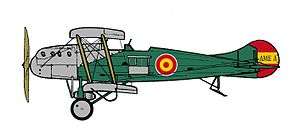AME VI
The AME VI was a reconnaissance aircraft, produced in Spain in the mid 1920s.[1]
| AME VI | |
|---|---|
 | |
| Role | Reconnaissance aircraft |
| National origin | Spain |
| Manufacturer | Aeronáutica Militar Española |
| Designer | Manuel Bada Vasallo and Arturo González Gil |
| First flight | 1924 |
| Introduction | 1925 |
| Primary user | Aeronáutica Militar |
| Number built | 20 |
Design and development
It was designed by pilot and engineer Captain Manuel Bada Vasallo assisted by Arturo González Gil based on the Bristol F.2b aircraft used at the time by the Spanish Military Air Arm (Aeronáutica Militar Española), hence its designation AME.
The two first prototypes were built in 1924 at the Aeronáutica Militar workshop in Cuatro Vientos. Conventional for its day, it was a biplane with staggered wings powered by a Hispano-Suiza 8Fb 220 kW (300 hp) engine. The twin-leg Lamblin radiators were mounted on the undercarriage. The pilot and observer sat in open cockpits in tandem.[2]
Twenty examples were produced for the Aeronáutica Militar of the Spanish Army in 1925 and 1926, being incorporated in the Grupo IV unit at Melilla, along with the existing Bristol F-2b. In February 1927 the AME VI were made part of the Escuela de Observadores training unit at Cuatro Vientos. They remained in service until December 1931 when they were phased out during the military restructuring promoted by Manuel Azaña, the newly nominated Minister of War of the republican government. Azaña's aim was to modernize the Spanish military and cut down the expenses of the state in the aftermath of the Great Depression.[3]
The AME VI was further developed with redesigned fuselage and tail unit as the AME VIA[4]
Specifications
Data from Encyclopedia of Spanish Military Aircraft[1]
General characteristics
- Crew: 2
- Length: 7.8 m (25 ft 7 in)
- Wingspan: 11.9 m (39 ft 1 in)
- Height: 3.6 m (11 ft 10 in)
- Empty weight: 870 kg (1,918 lb)
- Gross weight: 1,250 kg (2,756 lb)
- Powerplant: 1 × Hispano-Suiza 8Fb V-8 water-cooled piston engine, 220 kW (300 hp)
Performance
- Maximum speed: 190 km/h (120 mph, 100 kn)
- Range: 500 km (310 mi, 270 nmi)
- Service ceiling: 6,100 m (20,000 ft)
Armament
- Guns: 1 × fixed backward firing machine gun in rear cockpit
- Bombs: Light bombs
See also
Related development
Aircraft of comparable role, configuration and era
Related lists
References
- Enciclopedia de la Aviación Militar Española: Vol. 1, Quirón Ediciones ISBN 84-87314-71-6
- Museo del Aire (1992). Maquetas del Museo del Aire: Aeronaves en España. CECAF. ISBN 84-7965-025-7
- Ignacio Hidalgo de Cisneros, Cambio de Rumbo, Ed. Ikusager, Vitoria 2001, pg. 273
- Grey, C.G., ed. (1928). Jane's all the World's Aircraft 1928. London: Sampson Low, Marston & company, ltd. p. 184c.
External links

- Birth, first steps and pre-war planes of the Spanish Military Aviation